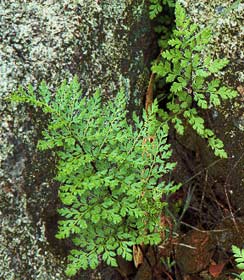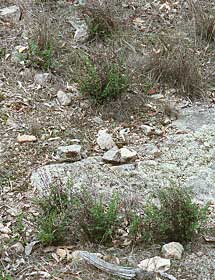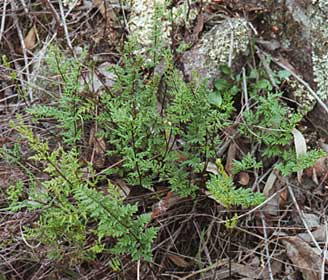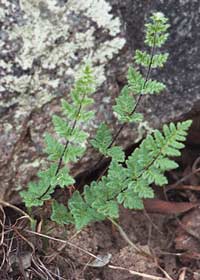Ferns and Fern Allies in the Canberra Region
Cheilanthes species
- Rock ferns
There are three species
of Cheilanthes recorded in the Canberra region, C. austrotenuifolia,
C. sieberi, and C. distans. It is very likely that they
hybridise, as there is a continuum of characteristics. The species overlap
in their ranges, so identification can be a bit tricky. At the extremes
of their ranges, they are easier to distinguish.
 C.
austrotenuifolia (Rock Fern) is the most elegant of the three species,
and in favourable situations (after a period of good rain, and with
suitable overcanopy) it is a beautiful lacy ground fern with fronds
up to 45 cm (18") long. The adjacent image shows a young specimen
growing among rocks. C.
austrotenuifolia (Rock Fern) is the most elegant of the three species,
and in favourable situations (after a period of good rain, and with
suitable overcanopy) it is a beautiful lacy ground fern with fronds
up to 45 cm (18") long. The adjacent image shows a young specimen
growing among rocks.
C. austrotenuifolia grows
in a range of habitats, including very dry areas, where its fronds are
often stunted and difficult to distinguish from C. sieberi (Narrow
Rock Fern). Both are amazingly hardy and grow on open rocky hillsides,
often among boulders, but sometimes in clumps in open grassland, subject
to frost, wind and direct sun. In its inclination to grow among grass tussocks, it resembles the "tree
fern Savannah" ecosystem of New Guinea, though on a micro-scale.
This habit is described in Duncan and Isaac's book Ferns
and Allied Plants of Victoria, Tasmania and South Australia .
The illustration at right shows the habit.
In its inclination to grow among grass tussocks, it resembles the "tree
fern Savannah" ecosystem of New Guinea, though on a micro-scale.
This habit is described in Duncan and Isaac's book Ferns
and Allied Plants of Victoria, Tasmania and South Australia .
The illustration at right shows the habit.
The photograph was taken
during a long drought in early winter. The hillside was covered with
small clumps of Cheilanthes (probably C. austrotenuifolia,
though C. sieberi was present nearby). This mix of grass tussocks
and Cheilanthes might be termed "Cheilanthes Savannah".
 C. sieberi usually grows in harsh areas, often in the open, and
appears to favour poorer soils than C. austrotenuifolia It is
reported to be poisonous to stock, though this is not a useful diagnostic
tool! Its fronds are usually up to 30 cm (12") in length and usually
stand upright. It grows among grasses, often among rocky outcrops. Earlier
suggestions that C. sieberi was a habitat form of C. austrotenuifolia
have been disproved by research in the 1980s.
C. sieberi usually grows in harsh areas, often in the open, and
appears to favour poorer soils than C. austrotenuifolia It is
reported to be poisonous to stock, though this is not a useful diagnostic
tool! Its fronds are usually up to 30 cm (12") in length and usually
stand upright. It grows among grasses, often among rocky outcrops. Earlier
suggestions that C. sieberi was a habitat form of C. austrotenuifolia
have been disproved by research in the 1980s.
 The
third Cheilanthes species is C. distans, or Bristly Cloak
Fern. It is superficially similar to small specimens of C. sieberi,
but clearly distinguished by the often thick scales and hairs on the
under side of its fronds. These are always visible on the unfurling
crosiers, which appear as fluffy white tips on new fronds (see illustration
at right). The amount of scales and hairs under the fronds varies considerably,
and may reflect hybridisation with C. sieberi. Some specimens
show sparse white hairs on the upper surface of the pinnae. C. distans
often grows among rocks in very frost-prone areas, where its hairs and
scales presumably confer competitive advantage. It resembles superficially
a specimen of Woodwardia distans I saw next to a fjord in Norway,
years ago, growing in a similar habitat. The
third Cheilanthes species is C. distans, or Bristly Cloak
Fern. It is superficially similar to small specimens of C. sieberi,
but clearly distinguished by the often thick scales and hairs on the
under side of its fronds. These are always visible on the unfurling
crosiers, which appear as fluffy white tips on new fronds (see illustration
at right). The amount of scales and hairs under the fronds varies considerably,
and may reflect hybridisation with C. sieberi. Some specimens
show sparse white hairs on the upper surface of the pinnae. C. distans
often grows among rocks in very frost-prone areas, where its hairs and
scales presumably confer competitive advantage. It resembles superficially
a specimen of Woodwardia distans I saw next to a fjord in Norway,
years ago, growing in a similar habitat.
It is possible that Cheilanthes
lasiophylla also grows in the Canberra region, but this remains
to be confirmed.

 David
Nicholls David
Nicholls
July 1998
|
 C.
austrotenuifolia (Rock Fern) is the most elegant of the three species,
and in favourable situations (after a period of good rain, and with
suitable overcanopy) it is a beautiful lacy ground fern with fronds
up to 45 cm (18") long. The adjacent image shows a young specimen
growing among rocks.
C.
austrotenuifolia (Rock Fern) is the most elegant of the three species,
and in favourable situations (after a period of good rain, and with
suitable overcanopy) it is a beautiful lacy ground fern with fronds
up to 45 cm (18") long. The adjacent image shows a young specimen
growing among rocks. In its inclination to grow among grass tussocks, it resembles the "tree
fern Savannah" ecosystem of New Guinea, though on a micro-scale.
This habit is described in Duncan and Isaac's book
In its inclination to grow among grass tussocks, it resembles the "tree
fern Savannah" ecosystem of New Guinea, though on a micro-scale.
This habit is described in Duncan and Isaac's book  C. sieberi usually grows in harsh areas, often in the open, and
appears to favour poorer soils than C. austrotenuifolia It is
reported to be poisonous to stock, though this is not a useful diagnostic
tool! Its fronds are usually up to 30 cm (12") in length and usually
stand upright. It grows among grasses, often among rocky outcrops. Earlier
suggestions that C. sieberi was a habitat form of C. austrotenuifolia
have been disproved by research in the 1980s.
C. sieberi usually grows in harsh areas, often in the open, and
appears to favour poorer soils than C. austrotenuifolia It is
reported to be poisonous to stock, though this is not a useful diagnostic
tool! Its fronds are usually up to 30 cm (12") in length and usually
stand upright. It grows among grasses, often among rocky outcrops. Earlier
suggestions that C. sieberi was a habitat form of C. austrotenuifolia
have been disproved by research in the 1980s.  The
third Cheilanthes species is C. distans, or Bristly Cloak
Fern. It is superficially similar to small specimens of C. sieberi,
but clearly distinguished by the often thick scales and hairs on the
under side of its fronds. These are always visible on the unfurling
crosiers, which appear as fluffy white tips on new fronds (see illustration
at right). The amount of scales and hairs under the fronds varies considerably,
and may reflect hybridisation with C. sieberi. Some specimens
show sparse white hairs on the upper surface of the pinnae. C. distans
often grows among rocks in very frost-prone areas, where its hairs and
scales presumably confer competitive advantage. It resembles superficially
a specimen of Woodwardia distans I saw next to a fjord in Norway,
years ago, growing in a similar habitat.
The
third Cheilanthes species is C. distans, or Bristly Cloak
Fern. It is superficially similar to small specimens of C. sieberi,
but clearly distinguished by the often thick scales and hairs on the
under side of its fronds. These are always visible on the unfurling
crosiers, which appear as fluffy white tips on new fronds (see illustration
at right). The amount of scales and hairs under the fronds varies considerably,
and may reflect hybridisation with C. sieberi. Some specimens
show sparse white hairs on the upper surface of the pinnae. C. distans
often grows among rocks in very frost-prone areas, where its hairs and
scales presumably confer competitive advantage. It resembles superficially
a specimen of Woodwardia distans I saw next to a fjord in Norway,
years ago, growing in a similar habitat.